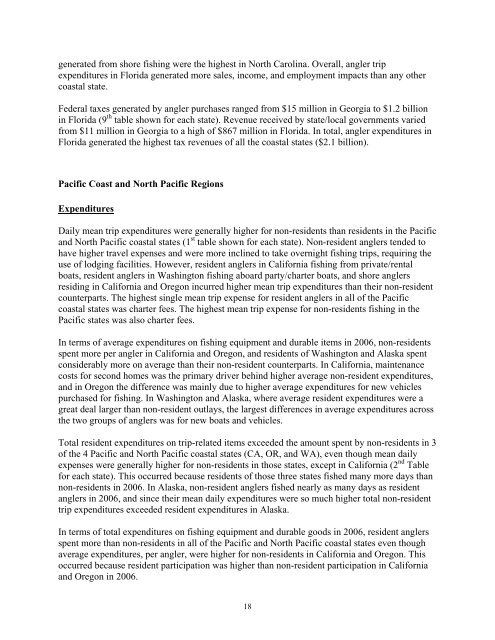The Economic Contribution of Marine Angler Expenditures in the ...
The Economic Contribution of Marine Angler Expenditures in the ...
The Economic Contribution of Marine Angler Expenditures in the ...
Create successful ePaper yourself
Turn your PDF publications into a flip-book with our unique Google optimized e-Paper software.
generated from shore fish<strong>in</strong>g were <strong>the</strong> highest <strong>in</strong> North Carol<strong>in</strong>a. Overall, angler trip<br />
expenditures <strong>in</strong> Florida generated more sales, <strong>in</strong>come, and employment impacts than any o<strong>the</strong>r<br />
coastal state.<br />
Federal taxes generated by angler purchases ranged from $15 million <strong>in</strong> Georgia to $1.2 billion<br />
<strong>in</strong> Florida (9 th table shown for each state). Revenue received by state/local governments varied<br />
from $11 million <strong>in</strong> Georgia to a high <strong>of</strong> $867 million <strong>in</strong> Florida. In total, angler expenditures <strong>in</strong><br />
Florida generated <strong>the</strong> highest tax revenues <strong>of</strong> all <strong>the</strong> coastal states ($2.1 billion).<br />
Pacific Coast and North Pacific Regions<br />
<strong>Expenditures</strong><br />
Daily mean trip expenditures were generally higher for non-residents than residents <strong>in</strong> <strong>the</strong> Pacific<br />
and North Pacific coastal states (1 st table shown for each state). Non-resident anglers tended to<br />
have higher travel expenses and were more <strong>in</strong>cl<strong>in</strong>ed to take overnight fish<strong>in</strong>g trips, requir<strong>in</strong>g <strong>the</strong><br />
use <strong>of</strong> lodg<strong>in</strong>g facilities. However, resident anglers <strong>in</strong> California fish<strong>in</strong>g from private/rental<br />
boats, resident anglers <strong>in</strong> Wash<strong>in</strong>gton fish<strong>in</strong>g aboard party/charter boats, and shore anglers<br />
resid<strong>in</strong>g <strong>in</strong> California and Oregon <strong>in</strong>curred higher mean trip expenditures than <strong>the</strong>ir non-resident<br />
counterparts. <strong>The</strong> highest s<strong>in</strong>gle mean trip expense for resident anglers <strong>in</strong> all <strong>of</strong> <strong>the</strong> Pacific<br />
coastal states was charter fees. <strong>The</strong> highest mean trip expense for non-residents fish<strong>in</strong>g <strong>in</strong> <strong>the</strong><br />
Pacific states was also charter fees.<br />
In terms <strong>of</strong> average expenditures on fish<strong>in</strong>g equipment and durable items <strong>in</strong> 2006, non-residents<br />
spent more per angler <strong>in</strong> California and Oregon, and residents <strong>of</strong> Wash<strong>in</strong>gton and Alaska spent<br />
considerably more on average than <strong>the</strong>ir non-resident counterparts. In California, ma<strong>in</strong>tenance<br />
costs for second homes was <strong>the</strong> primary driver beh<strong>in</strong>d higher average non-resident expenditures,<br />
and <strong>in</strong> Oregon <strong>the</strong> difference was ma<strong>in</strong>ly due to higher average expenditures for new vehicles<br />
purchased for fish<strong>in</strong>g. In Wash<strong>in</strong>gton and Alaska, where average resident expenditures were a<br />
great deal larger than non-resident outlays, <strong>the</strong> largest differences <strong>in</strong> average expenditures across<br />
<strong>the</strong> two groups <strong>of</strong> anglers was for new boats and vehicles.<br />
Total resident expenditures on trip-related items exceeded <strong>the</strong> amount spent by non-residents <strong>in</strong> 3<br />
<strong>of</strong> <strong>the</strong> 4 Pacific and North Pacific coastal states (CA, OR, and WA), even though mean daily<br />
expenses were generally higher for non-residents <strong>in</strong> those states, except <strong>in</strong> California (2 nd Table<br />
for each state). This occurred because residents <strong>of</strong> those three states fished many more days than<br />
non-residents <strong>in</strong> 2006. In Alaska, non-resident anglers fished nearly as many days as resident<br />
anglers <strong>in</strong> 2006, and s<strong>in</strong>ce <strong>the</strong>ir mean daily expenditures were so much higher total non-resident<br />
trip expenditures exceeded resident expenditures <strong>in</strong> Alaska.<br />
In terms <strong>of</strong> total expenditures on fish<strong>in</strong>g equipment and durable goods <strong>in</strong> 2006, resident anglers<br />
spent more than non-residents <strong>in</strong> all <strong>of</strong> <strong>the</strong> Pacific and North Pacific coastal states even though<br />
average expenditures, per angler, were higher for non-residents <strong>in</strong> California and Oregon. This<br />
occurred because resident participation was higher than non-resident participation <strong>in</strong> California<br />
and Oregon <strong>in</strong> 2006.<br />
18
















